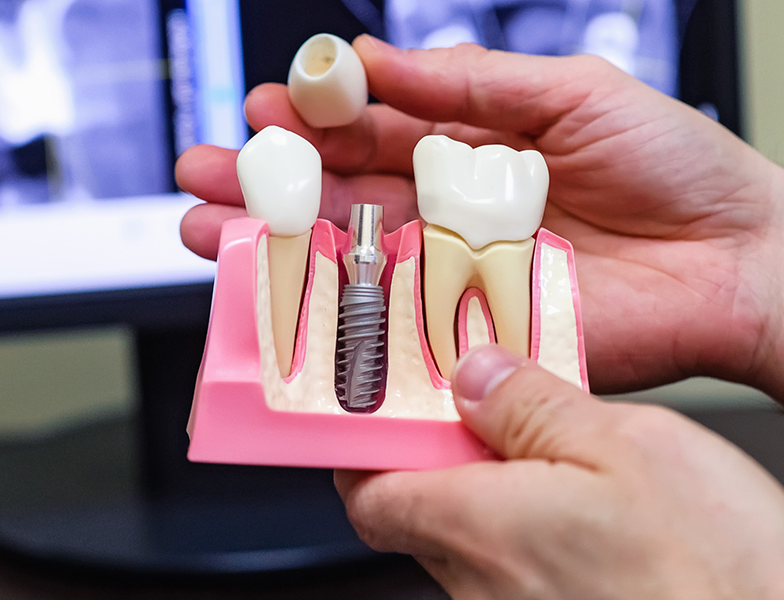Dental Implant
Dental implants are artificial tooth roots made of material compatible with human tissues placed in the jawbone in order to restore the function and aesthetics of the missing teeth. They are screw-shaped structures produced in various sizes and diameters, designed to mimic tooth roots, mostly made of improved titanium.
Dental implant treatment is performed in two stages. The first stage is the preparation of a suitable slot for the size and diameter of the implant in the area where it will be placed in the right position and ideal angle without damaging neighboring teeth, soft tissues and other anatomical structures, and the surgical stage in which the implant is placed in the subsequent slot. After the implant is placed inside the bone, the healing process begins, which is necessary for it to become part of the body, to fuse with the bone. This process is approximately three months, but in some cases it may be shorter or longer. With the end of the waiting period, the second stage is started and the construction of the prostheses planned at the beginning of the treatment on the implants is started. It varies between two days and two weeks depending on the type of prosthesis to be performed at this stage.
Who can dental implant treatment be applied to?
Dental implants can be applied to every individual who has completed jaw development without health problems and even by using advanced surgical techniques in cases where the jawbone is voluminously adequate and even the bone is not enough. Whether the amount of bone in the missing tooth area planned for implant treatment is sufficient, the patient’s current oral health and the patient’s habits (smoking, alcohol use, tooth tightening, etc.) are evaluated. However, in order for the treatment to be successful, the systemic condition of the patient should be evaluated very well when planning the treatment. If there is uncontsupervised diabetes, diseases concerning bone metabolism, cardiovascular diseases, bleeding clotting disorders, as well as chemotherapy or radiotherapy treatment, the patient must be consulted in writing with his/her doctor.
Implant Treatment Process
There may be intense concern in patients regarding the surgical stage of implant treatment. However, he can easily say that every patient who has had an implant has experienced a tooth extraction in his past and is nervous because he compares this procedure to tooth extraction. However, the implant placement phase is a simpler, painless and comfortable procedure for the patient than the tooth extraction process and is completed in about 10 minutes. The patient does not have any problems if he follows the recommendations of his doctor after the procedure and uses his prescribed medications correctly. The prosthesis part, which is the second stage of treatment, is almost identical to normal prosthesis procedures and is trouble-resistant for the patient. Preferably, between two stages, the patient can be used in temporary prostheses for functional purposes.
Since the implant placement process is a surgical procedure, it is preferably appropriate to do this procedure by a ‘Jaw Surgery Specialist’. The approaches and experiences of a physician specializing in this field before, during and after the procedure will have more positive results for the patient. The environment in which the treatment will be performed should be a sterile environment in accordance with the requirements of surgery. Sterility and suitability of all materials to be used is the responsibility of the physician. It is important that the physician and the auxiliary personnel are competent in their work as well as the suitability of the environment.

Request Appointment
After Implant Treatment
The process by which dental implants made of titanium merge with the bone to become part of the body takes place with a very different mechanism than live organ transplants. Therefore, this treatment method does not mention cases such as tissue mismatch and blood mismatch and there is no need for special tests before the procedure. There is no proven scientific basis for the condition, which is characterized in society as rejection of dental implants by the body. Likewise, there are no published scientific studies that suggest that titanium used in the production of dental implants causes an allergic reaction or causes other diseases.
After the implants are implanted, their failures can be mentioned as a result of their inability to integrate with the bone. The first reason for the unsuccessful treatments is the cases in which infections occur around the implants as a result of the patient not paying attention to the recommendations of the physician after the procedure. This is followed by malpractac treatment planning and inadequate surgical technique. To summarize briefly; In light of the results of scientific studies conducted on the subject for more than 30 years, the success of dental implants is reported between 90-98 percent taking into account various conditions and brands. In other words, the failure of dental implants is almost nonexistent when appropriate conditions are met and an accurate treatment process is followed.
In addition to being able to treat one or more tooth loss with dental implants, it is possible to provide treatment using dental implants in cases where the patient loses all his teeth. In a patient who has lost all his teeth, the necessary ground can be prepared for a fixed prosthesis by placing eight implants in a jaw. The number of implants to be implanted may vary depending on the patient. However, dental implants can also be used to provide retention. In patients with intense bone loss and who are afraid of advanced surgical procedures, 2 or 4 implants can be placed on one jaw and moving prostheses can be made on these implants. In this treatment option, the aim is to raise the patient’s standard of living with prostheses that provide aesthetics and do not move during the function.
